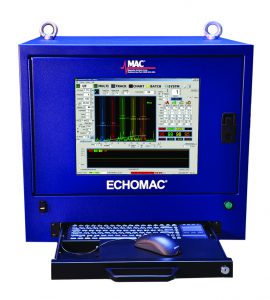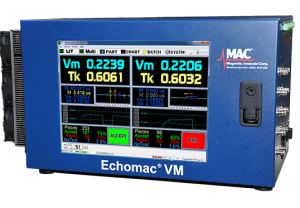NODULARITY INSPECTION
Nodularity Inspection of Ductile Cast Iron Automotive Components
As the use of nodular graphite iron material has expanded in recent years for automotive safety parts, ultrasonic velocity measurement is providing a reliable, industry accepted means of verifying material integrity.
Unacceptable degrees or variations in Nodularity, a type of graphite structure than can develop during the production process, can attenuate the velocity of sound waves passing through the material.

The Echomac® VM, measures this sound velocity, and using known limits, reports whether the part is acceptable.
About Nodular Cast Iron:
- When graphite takes the form of spherical nodules, the result is nodular cast iron.
- Nodular cast iron is softer and more malleable than gray cast iron.
- The relative high strength and toughness of nodular cast iron provides advantages in many structural applications including automotive crankshafts, pistons and cylinder heads.
- Microscopic examination and tensile strength tests are effective for checking nodularity, but they take time and are destructive.
- The Echomac® VM is a simple, effective instrument that measures velocity to assess nodularity in ductile iron cast automotive components.
ECHOMAC® FD6 MULTICHANNEL UT
For Flaw Detection, Thickness & Dimensional Measurement
in Tube & Bar
- Versatile Ultrasonic tester with superior performance and versatile, intuitive operation.
- For full inspection of tubes, pipes and bars, plate and weld.
- Operate on or off line
- Upgrade and/or replace older ultrasonic testers
- Use with rotary, spin-the-tube, squirter and bubbler installations.

ULTRASONIC TECHNOLOGY IN NDT
High-speed Ultrasonic (UT) Systems enable a full volumetric examination of materials and are designed to detect surface, subsurface, internal and dimensional flaws.
This type of testing utilizes high-frequency sound waves that are transmitted throughout the material being tested in order to conduct a thorough inspection.
- An ultrasonic wave is a mechanical vibration or pressure wave similar to audible sound, but with a much higher vibration frequency. For NDT purposes, the range is usually from 1MHz to 30MHz or higher.
- Depending on the test requirements, these waves can be highly directional and focused on a small spot or thin line, or limited to a very short duration.
- Two methods of UT are used for flaw detection – Shear and Compression Wave.


